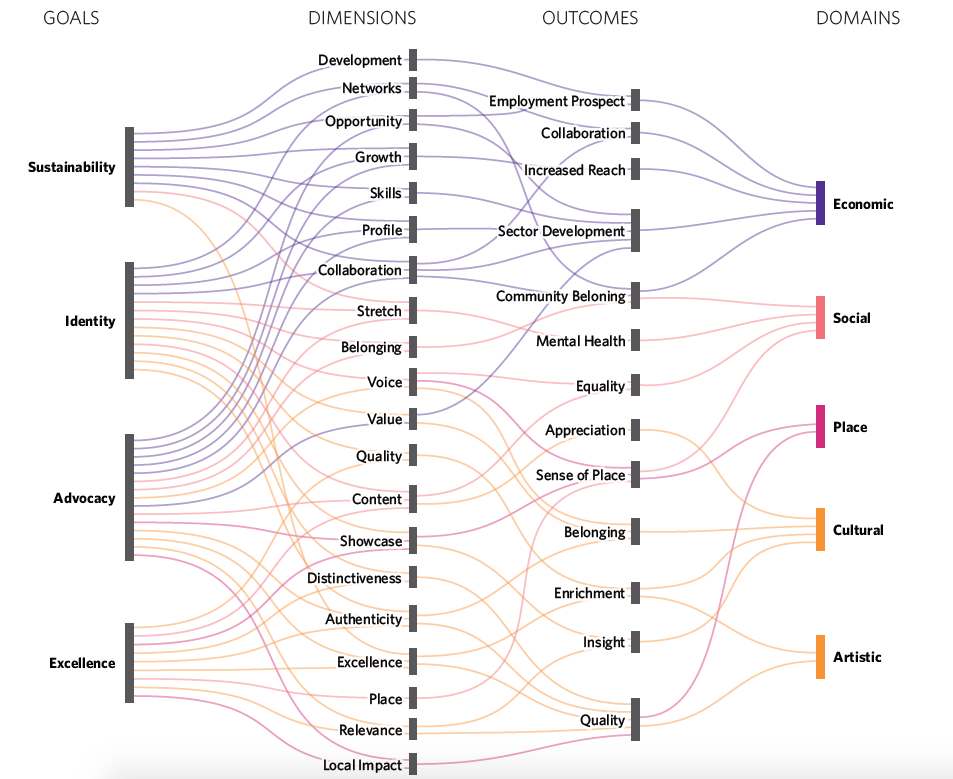As Australia’s longest running arts festival, there’s no doubt that the annual Perth Festival program of international performance, film, literature and visual arts has had a significant impact on Western Australians as well as visitors to the state.
Update: The Perth Festival 2020 Impact Report has now launched. The report showcases highlights, outcomes and achievements from the Festival which ran from 7 February to 1 March 2020, and reveals the enormous cultural and economic impact achieved by the Festival this year.
Click here to read the Perth Festival 2020 Impact Report.
“We now have a better understanding of our audiences, where they come from, why they engage with us and how we can continue to engage with them in the future.”Perth Festival Read report
Requirement
The unique impact of Perth Festival’s annual program
May 2019
In the lead up to the 2018 Festival, Perth Festival engaged Culture Counts to establish an evaluation framework that measures the event’s unique impact on its audience members and stakeholders, in an aim to quantify the significant artistic, cultural, place-based, social and economic outcomes that the Festival achieves with its diverse program each year.
Nathan Bennett, the Executive Director of Perth Festival said that; “This is Perth’s Festival’s second year using the Culture Counts model, and it has become a central part of our organisational planning. We now have a better understanding of our audiences, where they come from, why they engage with us and how we can continue to engage with them in the future.”
Approach
After two years of evaluation and the analysis of almost 11,000 survey responses from attendees, participants, partners, donors and organisers, Culture Counts published the second Perth Festival Impact Report in May 2019. The in-depth report builds on the foundations laid out in the inaugural 2018 Report, while using the opportunity to explore new findings alongside benchmarks that were set within the first stage of evaluation.
A set of Culture Counts ‘dimension’ metrics were identified as part of the framework and have been used across all surveys, as indicators that align directly to Perth Festival’s Strategic Goals identified in its Strategic Plan 2018-2022; Excellence, Advocacy, Identity and Sustainability. The links between the Festival’s Strategic Goals, the dimensions and associated Outcome domains are illustrated in the below diagram.

In the alignment, the dimension results contribute to the Festival’s realisation of core outcomes. By linking these outcomes and indicators back to the Festival’s Strategic Goals, we can see the pathway between Perth Festival’s strategic intentions and their realisation.
The Report’s program-by-program analysis identifies the strengths of each of Perth Festival’s key programming streams and provides an understanding of how collectively they do their part in achieving desired outcomes. For example, the shows that were part of the Made in WA program were integral in helping the Festival realise it’s cultural and artistic outcomes, by having a strong connection to the state and by being distinctive, with most respondents agreeing that these shows were different to things they’d experienced before.
For the first time, Culture Counts implemented a statistical clustering analysis that grouped individual shows together based on their dimension results, highlighting shows with unique combined impacts and demonstrating the overall strength of Perth Festival’s diverse program. An example of this correlation was seen for the performance by post-metal band Deafheaven and the contemporary dance piece Dada Masilo’s Giselle – two very different shows – however both realised similar outcomes for their respective audiences, receiving some of the highest results for the ‘Content’ and ‘Relevance’ dimensions, meaning that the relevance of these productions was in their ability to speak to the audience about their perception of today’s world.
In addition to the evaluation of intrinsic value and program performance, the Impact Report contains a comprehensive Economic Impact and Tourism Impact Summary. Mr Bennett acknowledged, “It is incredibly important for us to be able to demonstrate our impact while also developing plans to secure the long-term future of the Festival… As a result of this process we are able to celebrate the positive impact the Festival has on communities, as well as the ongoing contribution the Festival has to the Perth economy.”
Outcome
The Report recognised the Festival’s significant contribution to the WA economy, with over $19 million direct impact, as well as its ability to attract a substantial number of visitors from interstate and overseas. This context highlights an opportunity for the organisers to target tourists when promoting future Festivals. Nathan Bennett commented; “The report is used as a key decision-making tool across the entire organisation. It is used to guide audience focused marketing strategies, upcoming development plans and programming evaluation.”
“A particular focus of our most recent report was on the potential tourism benefit the Festival can bring to WA. More than 7,300 overseas and interstate visitors made a big economic impact on WA through the Festival in 2019, recording 26,650 attendances and staying a combined 65,112 nights while they were here. Forty per cent of surveyed tourists said they had come to Perth specifically for the Festival. The insights we gained from the report have been a real asset in making strategic plans in this area.”
Mr Bennett added that the Impact Report has become integral to their ongoing discussions with partners and donors, and that the data helps them quantify their impact; “Culture Counts has helped Perth Festival to communicate more effectively with our stakeholders, partners and donors. It is an important tool which helps us to showcase our impact in tangible ways while also highlighting areas for growth and future development.”
“The report illustrates the powerful connection that can exist between the arts, the wider economy and tourism opportunities in the state. For our key stakeholders it clearly demonstrates the impact that their support can have on the community.”





